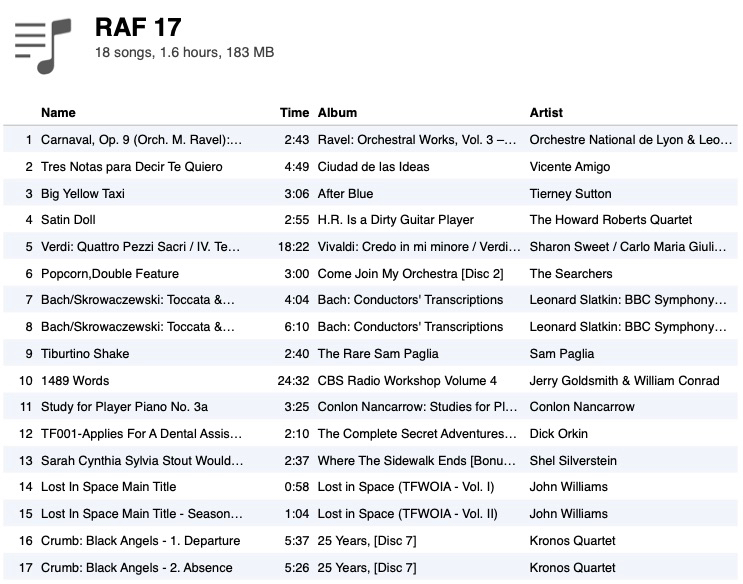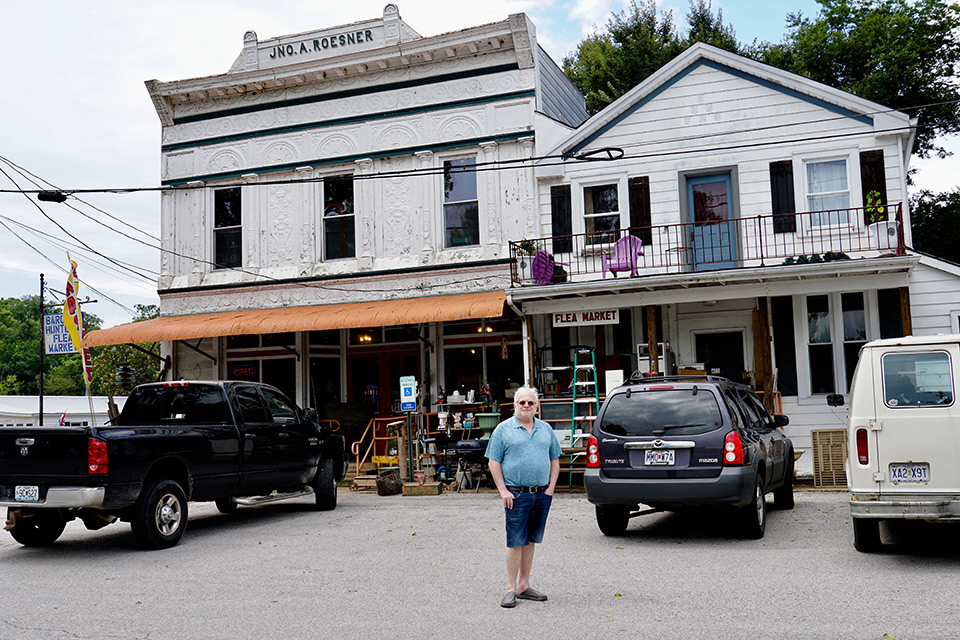Lurking around the corner is the monster simply known to me as 75. This is not to be confused with the film that will hit theaters soon, It: Chapter Two, but the comparisons are not too far off. There is this entity that tries to lure both young and adult human beings into another world. In the Stephen King story, it is simply to scare the bejesus out of those watching events unfold, and in my life story, it is a landmark both to be appreciated and a little frightened of. I do know that Pennywise wears more makeup than I do.
Prior to the first of September, for me AKA b-day, I only had one conducting assignment during the month of August. But it was an important one, as it marked a milestone in my podium history. When I was the assistant conductor in St. Louis, my mentor—former executive director of the Chicago Symphony John Edwards—had been keeping a watchful eye on my development. He had engaged me to do a concert with the Chicago Civic Orchestra and felt I was ready to move on to the parent organization.
In the summer of 1972, I stepped onto the podium at Ravinia, the suburban home of the CSO during July and August. But John and then-head-of-the-festival Edward Gordon were smart. This was not a regular program, but rather a children’s concert. It was preceded by an event in the parking lot of a shopping mall the day before. Slow steps, but ones that were meant for something longer range. It would turn out that I was one of the few conductors who led the orchestra both in Orchestra Hall and in the Pavilion in Highland Park.
Now, 42 years later, I once again saw the orchestra that I have worked with for so many years, this time in anticipation of the movie that would commence at the beginning of this month. It turned out that I was a sort of replacement conductor, as the originally scheduled one had withdrawn several months earlier. I knew that my soloist would be Denis Matsuev, with whom I had performed the Third Rachmaninov Concerto in the same place 11 years ago. The other work was Scheherazade, the colorful Rimsky extravaganza that used to be played all the time but has fallen a bit out of the sun these days.
The CSO had performed Scheherazade several times in the winter with Ricardo Muti, having played it both in Chicago and on tour. At first, I was reluctant to take it on, as my approach could either have been similar or completely different. With the work fresh in the heads and fingers of the orchestra, there is a risk of comparison. But right from the downbeat at the rehearsal, it was clear that the orchestra was interested in a different viewpoint, and I had several ideas that were new for them. It all made for a most delightful, if unpleasantly hot evening. It was nice to see so many familiar faces, including musicians who had played with me at my first appearance with the orchestra.
Cindy and I decided that making the five-hour drive from St. Louis was preferable to flying. We figured by the time we got to the airport, checked in, went through security, waited, got to O’Hare and then drove to the hotel, the time incurred would be about the same anyway. Plus, my wife has a new car, and she wanted to put it to the test. It is not the most spectacular drive up Interstate 55, but having the vehicle was handy in getting around for a couple days.
Now, with conducting out of the way for almost six weeks, I could focus on other projects. There is a piece that will be premiered in October, and I had to write my portion of it. That sounds strange, so here is the little program note that goes along with the work, to give you an idea of what I am talking about:
In 1996 I gave my final concert as music director of the St. Louis Symphony. For the occasion, we asked the four composers who were in residence during my tenure to write a variation on the famous theme from the 24th Caprice by Niccolò Paganini. Joseph Schwantner, Joan Tower, Donald Erb and Claude Baker each offered a different take on the tune. In addition, William Bolcom and I contributed short interpretations of our own.
Although the idea for several composers to create a single variation intended to be performed alongside other arrangements was new, the original theme is probably the most popular classical music tune to be subjected to various treatments. Indeed, Brahms, Schumann, Lutosławski, Blacher, Rachmaninov and even Andrew Lloyd Webber have all turned to Paganini for inspiration.
As I approached my 75th birthday, it occurred to me that expanding on this idea from 23 years ago would be a nice way to celebrate. I invited five orchestras where I have held a position of artistic leadership to commission five composers with whom I have shared a close collaboration over the course of my career. Specifically, the St. Louis Symphony invited John Corigliano to contribute a new variation, as it was with that orchestra that I first conducted and recorded John’s music. Composer Truman Harris served as second bassoon in the National Symphony and assisted me in orchestrating several works I wrote for that ensemble. Guillaume Connesson was resident composer with the Orchestre National de Lyon during my tenure. Cindy McTee, aka Mrs. Slatkin, was closely associated with the Detroit Symphony Orchestra. Daniel Slatkin is my son and a composer for motion pictures and television. His variation was commissioned by the Nashville Symphony, one of the most active recording orchestras in the country.
Putting all 11 variations together to form a single piece was not an easy task. I wound up writing an introduction as well as some connective material to cover setup changes in the percussion section. I determined the performance order with an eye toward balancing the serious pieces with the often outrageously humorous ones. I am grateful to the various publishers for allowing their composers to sit next to each other in the same work, and to the commissioning orchestras for supporting the project.
A word about my own variation is in order. When I wrote it in 1996, I tried to take an element of each composer’s style and incorporate it into a finale. With five new authors in the mix, I needed to create additional passages so that all 11 contributors would be represented. Most of this material is intended as a little tribute to my friends who so graciously participated in the celebration of this three-quarters-of-a-century milestone. If you keep in mind that my son writes for film and television, Connesson is French, and Harris is a bassoonist, I think you will catch on.
Five orchestras will play the piece, and if it turns out to be interesting, perhaps it will have a longer life after the initial performances. I also received the gracious invitation to write an original work for the 50th anniversary of the St. Louis Symphony Youth Orchestra, an ensemble I founded in my second year as assistant conductor. Ideas have been swirling about in my head, but I am pretty sure of what I want to do with this piece. It will have something to do with the first notes the orchestra produced during my first rehearsal with them.
Since my return to the Archway city, I have resurrected a radio show I started when the orchestra went on strike in 1968 and I had little to do but wait it out. An underground operation, known as KDNA, invited me to a rundown house located in the former nightlife area of the city, Gaslight Square. Most people on the staff lived in the station, and whoever woke up first in the morning turned the transmitter on. During the course of the conversation, I was asked if I wanted to have my own show. Reluctantly, I said yes, and for three years, every Thursday afternoon, listeners were treated to a program called, modestly, The Slatkin Project.
When I returned here a year ago, I decided to see if it was possible to do something similar in the 21st century. The original show was four hours long, and the new one would be half that length. It is based on the premise that random selection can be as interesting as well-calculated programming. Basically, I put my iPad on shuffle mode and play whatever Betsy, a name randomly selected, comes up with. The variety of music, drama, comedy, and other forms of entertainment has probably confused people who are accustomed to classical works on RAF, the call letters of the station. But I have had a great time doing it.
We record five programs at a time, as the selections can be dropped in at any point after I have done the intros and outros. Sometimes I pepper the hosting by telling anecdotes or stories about the artists or actual music. Every so often, we break the format by doing programs based on one subject, but still with random selection by Betsy, within the files contained on my computer.
Here is an example of what gets played. These are the tracks, and as you can see, there certainly is a lot of variety to be heard:
If you are interested in tuning in, it airs on Saturdays at 10 p.m., Sundays at 4 p.m. and Tuesdays at 7 p.m. Central. Listen to the livestream here. We hope to turn it into a podcast very soon.
***
With all this time off, I decided to try an experiment, something that I considered for some of the time following my bypass surgery. At the beginning of this year, some of you may remember that I wrote a bit about the joys of going to an actual barbershop, something harder to find in these days of salons and spas. It was in Louisville, and I got a hot towel shave. This time, I wanted to try and grow a beard.
With no social engagements on the calendar, I could simply stay out of the public forum and let the follicles bloom without fear of laughter from others. Bernstein tried something like this a bit later in his life but gave up rather quickly. There is a video of his performance of Mahler’s Sixth Symphony with the Vienna Philharmonic showing the maestro sporting facial hair. One can see why he abandoned the goatee.
As each day passed, I would check things out in the mirror. Sometimes I thought it was going to look nice, and other days I wanted to shave it off. With three generations of barbers in my family, I wished that I could consult with them, but they have been long gone. I knew that at some point, I would have to decide on a style for this new look.
The internet turned out to be somewhat useless as a tool for finding out what I might look like. There are apps that allow you to put a beard onto a picture of your face. Perhaps the electronic version was not an accurate representation of how it might turn out, but none of the styles seemed to suit me, unless I was considering becoming a pirate. Since it was time to get a haircut anyway, I figured that the best person to consult would be my own stylist.
David was very helpful. We discussed jaw line, sideburns, length and just about everything possible. He determined that I would look fine and thought that things were coming in nicely for just two weeks of growth. I felt like a flower in a pot, sitting by the window waiting for the sun to rise. He also told me about all the equipment I would need. Seems that just a razor will not do. There are trimmers, shapers, beard balms and many other elements that go into a proper grooming.
David, using the small lawn mower, attempted to give my countenance some semblance of order. I felt encouraged but still wondered how much longer it would take to fill in. It was necessary to have something decent to show as my birthday approached. God forbid that my son should see his dad as a hobo.
With another appointment scheduled in two weeks, I knew that a month of whiskers would more than likely be in place before my first real public appearances. I went to a beauty supply store and purchased all the accoutrements needed for proper beard maintenance. Then it was time for lunch.
Twice a week, when I am in St. Louis, I head to my favorite Chinese restaurant in town. The co-owner of the establishment is an exuberant woman who greets most customers with a hearty “Welcome home.” Seated in a booth away from the throngs who come for the daily dim sum, she got up and strode over to the table. In no uncertain terms, she said that I needed to lose the beard. “It makes you look 15 years older.”
After this depressing opinion, I started thinking about all the work I would have to put in to maintain the bristles. And I really did not want to look like a 90-year-old bum. While I was with David, he had told me that he needed to go have his very light facial growth trimmed, as he was off to a funeral the next day. I wanted to know why he didn’t have someone at his establishment do the trimming, and he said his staff was afraid to do it.
After learning where he went, I decided to head downtown and get my face to return to its boyish-looking self. Lo and behold, it was a real barbershop. Without an appointment, I had to wait about two hours to get in, so I took that opportunity to drive around an area of town that I did not know so well. Settling back into the men’s grooming parlor, I got the Louisville treatment. My barber said that a beard was just not for every man, and with hot towels surrounding my face, I already knew that this decision was the right one.
When he finished, I put my hands to my face, felt the smoothness and breathed a sigh of relief. Shorn of the stubble, I could actually recognize myself again. At home, Cindy expressed her satisfaction with my decision. It remains to be seen what will be said at the Chinese restaurant. Still, once in a while, I put hand to face and kind of miss the feeling that I am petting a small dog.
Did I take any pictures while growing the beard in? Yes, but you will never see them. They rest in a remote place somewhere in the cloud. My 75th birthday will pass without anyone ever knowing what I will look like 15 years from now.
***
The new book is coming along well. Robert Freeman, former head of the music departments at both the Eastman School of Music and the University of Texas at Austin, and I are gathering information from professionals connected with as many aspects of the musical world as possible. The intent is to come up with some possible solutions for the travails faced by the performance and educational world as regards the state of the arts in the United States. Hopefully, all the research and interviews will be completed by the end of this month and we can come to some conclusions as to where we go from here.
Cindy and I had a lovely day exploring a part of Missouri I had never been to in all my years here. Taking mostly blue highways, not those boring old interstates, we had a great time discovering parts of this state’s heritage. Our destination was a city called Hermann. Most people think that St. Louis was predominantly settled by the French, but as with portions of neighboring Illinois, there was a huge German presence as well. The city was founded by the Deutsche Ansiedlungs-Gesellschaft zu Philadelphia (German Settlement Society of Philadelphia) in 1837. Now that is a mouthful, as were the creative sausages served during our lunch break at an establishment known for its wursts. They were the bests. Cindy took some great pictures of the town as well as a couple of the stops we made along the way.
***
***
***
***
Critic’s Corner
Cindy and I really got into The Crown, a series about the early years of Queen Elizabeth ll, which focuses on the challenge forced onto the young monarch following the death of her father. Maybe my English readers do not look at this series in the same way as we do, but this combination of history and a little bit of soap opera is very engaging, terrifically written and researched, and cast perfectly.
It will be interesting to see how the producers handle events as they become more recent and a bit closer in memory as to what we know. At the moment, we are about halfway through the second season, so the Queen and the really tortured Prince Phillip are trying desperately to salvage their marriage. Since they are still together, I guess they figured that out.
On the lighter side, there are two American series that have captured our attention and contain some outright laugh-out-loud moments. Grace and Frankie, starring Jane Fonda, Lily Tomlin, Martin Sheen and Sam Waterston, is a look at two aging couples. But after many years of being together, it turns out that the two men have been in a relationship with each other for quite a long time. Watching these veterans serve up some of the best comedic moments on TV has been delightful.
Then there is Schitt’s Creek. A very wealthy businessman, Eugene Levy, loses his fortune to his partner, and is left only with the ownership of a small town. Forced to move to a motel in this rural setting, he and his wife, the great Catherine O’Hara, as well as their two kids, live in adjacent rooms, where all can be heard and sometimes seen. Again, as with the above series, there are moments that are truly hysterical, and the cast, particularly Levy’s real-life son, is terrific. I did not expect to enjoy this show as much as I have.
Way too many books about the Trump administration have appeared. One can only imagine the glee on the publishers’ faces as events take turns that might have been appropriate for almost any one of the television shows mentioned above. There are days when I really do not want to turn on the news, but the drama that unfolds each day causes a severe case of carpel tunnel syndrome as I flip the remote from channel to channel. Kudos to Brian Williams, who hosts The Eleventh Hour on MSNBC. His professionalism and sense of humor are something we do not see often these days. Very rarely does he stammer or pause when completing what he has to say.
***
This post comes early, as I have a feeling there are several surprises in store over the next few days. More than likely, I will write something early in September, but if you have not done so, follow me on Facebook, Twitter and Instagram to see a timeline of significant events that have occurred during my life. Those are about the past, and I tend to think about what is next.
See you soon,
Leonard




